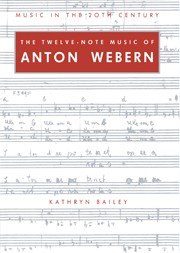Summary
The primary task of analysis is to show the functions of the individual sections: the thematic side is secondary.
In the autumn of 1924, at the age of forty, Anton Webern wrote a piano piece of seventeen bars based on a twelve–note row and in so doing unconsciously launched what was to become one of the most contentious movements of this century. Although Webern is not credited with the formulation of twelve–note technique, it was his style rather than Schoenberg's that the later serialists saw as suggesting the intense organization that characterized their music of the 1950s and 60s. As the result of the unsolicited but outspoken admiration of composers like Boulez and Stockhausen, Webern himself, after his death, came to be associated in the public consciousness with the most progressive aspects of integral serialism. Whether he would have welcomed this role is not clear. His comments about himself and his music, as transmitted by Willi Reich and others, show an unswerving commitment to tradition, to the idea that in contributing to the ‘New Music’ he was also upholding values of the past. This recognition of the essentially traditional aspect of his twelve–note music forms the basis of the present study.
The period under consideration spans the years from 1924 to 1943 and embraces both instrumental and vocal music. The accompanied solo songs (four sets in all) were written in two short periods separated by nearly a decade.
- Type
- Chapter
- Information
- The Twelve-Note Music of Anton WebernOld Forms in a New Language, pp. 1 - 8Publisher: Cambridge University PressPrint publication year: 1991

